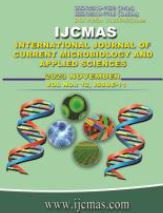


 National Academy of Agricultural Sciences (NAAS)
National Academy of Agricultural Sciences (NAAS)

|
PRINT ISSN : 2319-7692
Online ISSN : 2319-7706 Issues : 12 per year Publisher : Excellent Publishers Email : editorijcmas@gmail.com / submit@ijcmas.com Editor-in-chief: Dr.M.Prakash Index Copernicus ICV 2018: 95.39 NAAS RATING 2020: 5.38 |
Cassava is an important staple grown worldwide for its edible leaves and roots. African cassava mosaic virus (ACMV) is the most important disease infecting this crop that reduces yield and quality. This study was conducted to determine the effect of ACMV infection on nutritional components of some cassava cultivars. The experiment was carried out at the University of Ibadan, Teaching and Research Farms. It was a randomized complete block design with four replicates using resistant, moderately resistant and susceptible cultivars. Proximate analysis was done to evaluate these nutritional components. Disease incidence and severity were highest for the susceptible [Index of Symptom Severity (ISS) =3.57 ± 0.01] cultivar and lowest for the resistant (1.36 ± 0.05) nine months after planting. Cyanide content was 37.1% for the resistant plants and 78.3% for the susceptible. Fibre and fat contents decrease significantly for infected plants compared to the uninfected irrespective of the cultivar. A decrease of 2.68% in protein content and an increase in biomass of 21.43% was noted for infected resistant plant compared to the uninfected. Index of Symptom Severity (ISS) and protein/sugar contents of cassava tubers were significantly positively correlated (P=0.05) on dry weight basis. There was significant negative correlation between starch/sugar and dry matter/moisture content of cassava tubers (r=0.9 and r=-0.8) respectively. On fresh weight basis, there was a highly significant negative correlation between ISS and moisture content (r=-0.6). Starch content was significantly positively correlated at P=0.05. Cyanide and dry matter contents had significant positive correlation (r=0.9, P=0.05). ACMV has an adverse effect on the nutritional components of cassava and therefore virus resistant cultivars should be used for planting.
 |
 |
 |
 |
 |